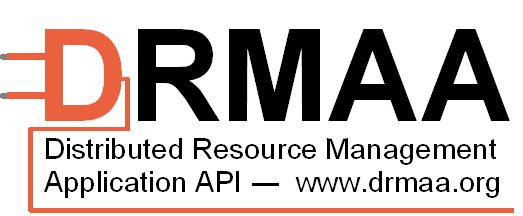- The Galaxy project code is able to use DRMAA for job submission, for example in the Polish Grid.
- The QosCosGrid QosCosGrid middleware supports DRMAA as backend for job submission
- The MOAB scheduler uses DRMAA to integrate with DRM systems
- DRMAA is being used by the LONI pipeline software for accessing compute backends. The LONI Pipeline is a free workflow application primarily aimed at computational scientists. With the LONI Pipeline, users can quickly create workflows that take advantage of all the greatest tools available in neuroimaging, genomics, bioinformatics, etc.
- eXludus Software uses C DRMAA in an integrated data grid solution for DRM systems
- European research project trusts on DRMAA for dynamic resource binding
- CombineNet, an ISV for optimization applications, uses Java DRMAA behind Web UI
- IT finance service provider uses C DRMAA to integrate mainframe and compute farm environment
- Sun Microsystems uses C DRMAA for SW compilation jobs
- ISV for finance applications uses Java DRMAA
- ISV for finance applications uses Python DRMAA
- LLNL Bioinformatics group uses Perl DRMAA module developed specifically for this project and later released on CPAN
- GridwiseTech developed Grid Engine 6 - Globus Toolkit 4 adapter that uses Perl DRMAA
- PSNC launched DRMAA service provider open source project OpenDSP for WS-based remote multi-user access to arbitrary DRMs
- a general purpose job workflow processor has been implemented based on DRMAA for Ruby binding
- The Mathematica integration package is based on Java DRMAA.
- EGEE uses DRMAA to port Fusion Applications and Biomed applications
- Molecular biologists at the University of Alabama at Birmingham (UAB) uses a DRMAA implementation of BLAST
- Tim Bornholtz from Georgetown University implemented a Thebes module which takes a JSDL description and submits the according job via DRMAA.
Hess Corporation: Use case for DRMAA.
Hess Corporation is a global integrated energy company engaged in the exploration and production of crude oil and natural gas, as well as the refining and marketing of petroleum products, natural gas and electricity. As part of our exploration activities, seismic data is acquired and processed to create images of the earth's subsurface which can be analyzed by geoscientists for indications of hydrocarbon deposits. In order to process the seismic data for a particular area, which can be several terabytes in size for a single seismic survey, we use a cluster based supercomputing facility, composed of several thousand CPU and GPU processors. To help manage the tens of thousands of individual application tasks created as part of the data processing and image generation workflow, we use a commercially supported grid engine software package. This grid engine software provides a "C-Programming language callable" DRMAA library which is used by our application front-end to submit the batch job streams which contain the processing and image generation tasks to the compute cluster for execution.
Please, send your DRMAA story to drmaa-wg@ogf.org to get it on this list.